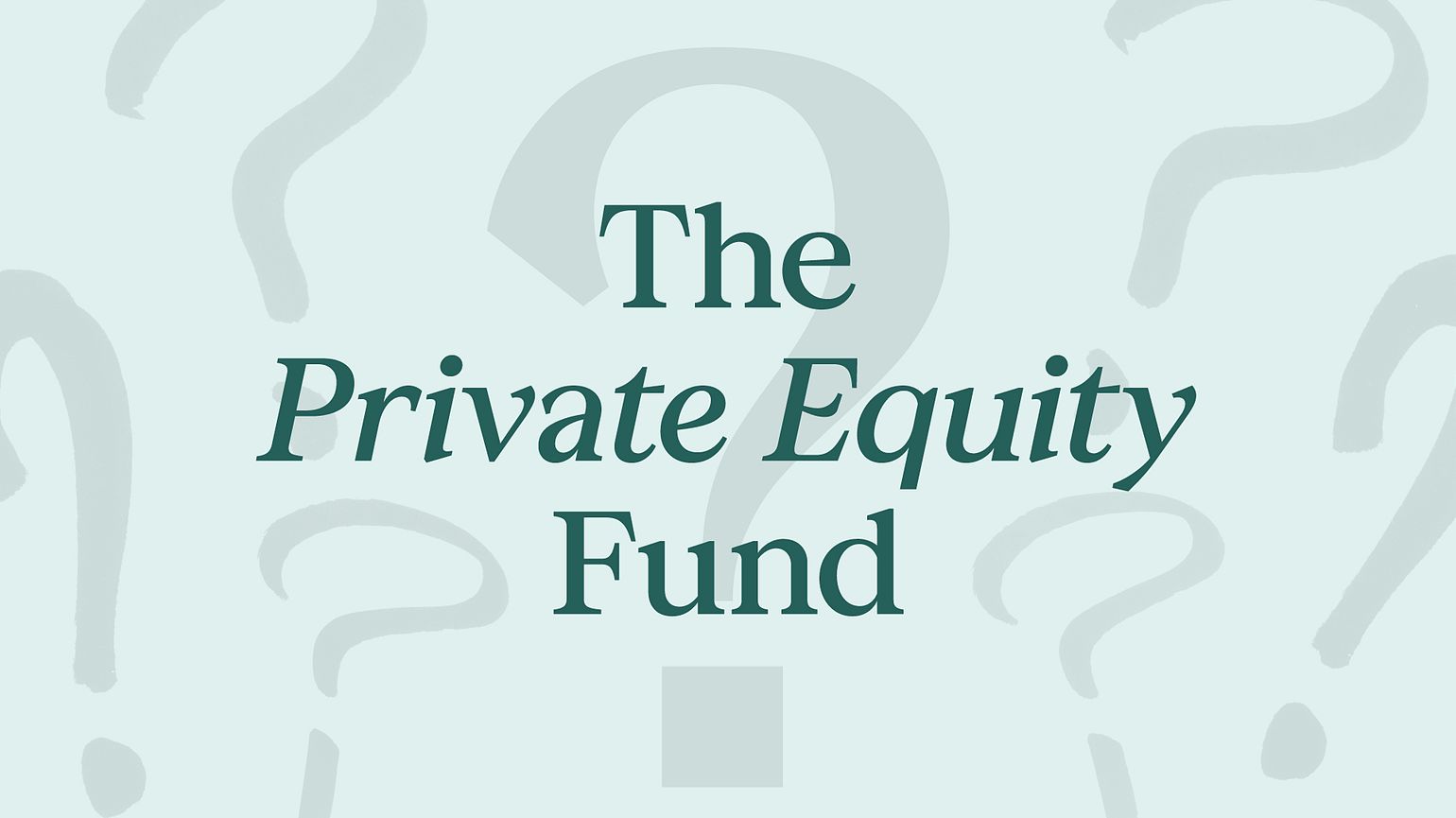What is a Private Equity Fund?


Learn the essentials of private equity funds—how they are created, raised, structured, and managed. This guide provides an overview of the lifecycle of PE funds, from raise to wind-down, and their governance.
- PE funds are created to pool capital from investors to acquire, add value to (by improving operations and ESG, for example), manage, and sell businesses to create long-lasting value.
Private equity (PE) funds are major players in the world of finance, known for their ability to drive growth, create value, and generate substantial returns for investors. Their effectiveness is why there are now more than $13 trillion in assets under management with private equity firms.
For those looking to understand what a PE fund is, this article dives into the essential aspects, from the reasons these funds are created to their fundraising processes, governance structures, and lifecycle stages.

Why are private equity funds created?
PE funds are created to pool capital from various investors with the primary goal of acquiring, managing, and ultimately selling businesses for a profit.
Historically, PE funds emerged to address market inefficiencies and capitalize on growth opportunities. They typically focus on sectors where they can make substantial impacts, such as technology, healthcare, and consumer goods. By acquiring stakes in companies, PE funds aim to transform good companies into great ones, driving innovation and growth.

How are private equity funds raised?
In PE, funds are raised from outside capital. This means most of the money comes from institutional investors (pension funds, insurance companies, sovereign wealth funds, etc.), but there are also many high-net-worth individuals who invest in PE funds. Whatever the makeup of investors, the process for raising funds is typically the same. Here are some of the key steps involved:
- Pre-marketing: Between 6-12 months before the official launch of a fund, the fund managers will test investor interest. This will typically take the form of informal discussions that allow fund managers to gauge investor appetite, build relationships and get early feedback on their investment strategy.
- Roadshow: the PE firm’s executive team will set up a series of presentations to promote their new fund to potential investors, allowing them to build some momentum and lay the foundations for a successful raise. The strategy, team, and terms of the fund are set out in a memorandum.
- Capital commitment: investors sign agreements to commit capital to the fund.
- Closing: wrapping up the fundraising process usually happens in stages. There may be an initial closing when a certain threshold (50-75% of target funds) is met, and then subsequent closings to allow additional investors to join.
Naturally, the success of a fundraiser is affected by the broader economic environment, and, in the current context, there is increasing competition for investment capital. This has driven many PE firms to up their game in building relationships and winning investments.

How are private equity funds structured?
A PE fund is typically set up as a limited partnership, a common investment structure that clearly sets out the roles, responsibilities and liabilities of all those involved. In a limited partnership, there are two main partners:
- Limited Partners (LPs): the investors who provide most of the capital in the fund are known as the LPs. They have ‘limited liability’, meaning they can only lose up to the amount they have invested.
- General Partner (GPs): the private equity firm that manages the fund is known as the GP. The GP has unlimited liability and is responsible for the fund’s operations. The GP will also invest in the fund. Traditionally, this has been somewhere in the region of 1-5%, but GP commitments are on the rise.
Beyond simply being a tried-and-tested model, this structure is used for a number of reasons. Firstly, there are tax benefits to setting up as a partnership, not a corporation. Secondly, it allows LPs to give control of funds to GPs, who can use their expertise in private equity to make investments. Thirdly, the limited liability setup protects LPs, who are not directly involved in fund management.
A final note on the fees paid under the typical limited partnership model. For overseeing the operations of the fund, the GP earns management fees. The industry standard has been 2%, but signs point to a general decrease in the future. However, these fees are complemented by ‘carried interest’, a share of the profits on the fund’s investments – typically 20%.

How do private equity funds work once set up?
Once a PE fund is set up and capital has been drawn down, the focus shifts to executing the investment strategy and managing the portfolio companies. We can treat these separately for simplicity’s sake:
- Investment period: usually lasting between 3-5 years, this phase sees the GP actively seeking out and acquiring target companies. The GP leans on its industry expertise and networks to find investments that align with the fund’s strategy. This process is rigorous and involves a lot of due diligence, including financial and market analysis to ensure that a target company has growth potential.
- Active management: once a target company has been acquired, the GP will take an active role in managing and improving it. There are many strategies at a GP’s disposal, but the most common include operational improvements, financial restructuring and providing strategic guidance to company management.
Ultimately, the goal of the GP is value creation. By improving the operational and financial performance of the fund’s portfolio companies, the GP aims to increase their market value. This in turn sets them up to capture that value in the form of profits when it comes to exiting their investment.

What is the governance of a private equity fund?
The governance of a PE fund is organized to ensure transparency, accountability, and alignment of interests between the partners. Here’s a general overview of the actors involved in the governance of the PE fund.
- The role of GPs: we’ve already learned that GPs are responsible for the day-to-day operations of the fund. This includes making investment decisions and creating value by working with portfolio companies, but it also includes reporting, ie. providing regular updates to LPs on the fund’s performance. Reports are typically published quarterly, while annual meetings are held to present the yearly performance of the fund.
- The role of LPs: Providing the majority of the capital is the main role of the LP, so they don’t get involved in day-to-day operations. That said, they do play an important role in terms of oversight and governance as members of Limited Partner Advisory Committees (LPACs).
- LPACs: these committees are made up of LP representatives and function as advisory councils to the GP. They meet regularly to review fund performance, offer advice and ensure the GP’s activities align with the interests of LPs.
In addition to the above, Financial Regulatory Authorities supervise the operations of regulated fund managers. Funds must meet legal requirements to operate as limited partnerships and the fund manager must implement compliance policies to adhere to financial regulations and anti-money laundering laws.

What is the lifecycle of a private equity fund?
The lifecycle of a PE fund typically lasts around 10 years, though there are indications that the average cycle may be lengthening. Each stage of the lifecycle is critical for the successful management and ultimate profitability of the fund. We have touched on some of the key stages already, but here’s an overview from start to finish.
- Fundraising: this phase involves raising capital and can last from a few months to a few years.
- Investment: once fundraising is complete, the fund begins a 3-5-year period of investing in target companies.
- Active management/holding: PE funds typically ‘hold’ their investments for 4-6 years, though again, this period now seems to be lengthening. During this time, the PE firms work on value creation with a view to increasing the market value of their portfolio companies.
- Exit: as the fund nears the end of its lifecycle, GPs focus on exiting their investments to earn a return for the LPs. Some of the most common exit strategies include initial public offerings (IPOs), trade sales, and secondary buyouts.
- Distribution of profits: once exits are completed, the profits are distributed among the LPs and GPs. The LPs get returns based on how much capital they invested in the fund, while GPs earn carried interest, a percentage of the profits (in addition to their management fees), through the lifecycle of the investment.
- Wind-down: this final stage sees the finalizing of all financial transactions, distributing any remaining assets and closing the accounts. The aim here is to ensure that all the obligations agreed to at the outset are met.
Creating and capturing value
Private equity funds play a crucial role in the financial ecosystem by pooling capital to acquire, manage, and transform businesses. From their creation to their governance and lifecycle, PE funds are structured to create and capture value through strategic investments and active management. Understanding how these funds operate gives an insight into their potential for generating substantial profits while driving growth and innovation in key industries.
ThinQ is the must-bookmark publication for the thinking investor.



